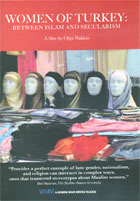
Women of Turkey: Between Islam and Secularism 2006
Distributed by Women Make Movies, 462 Broadway, New York, NY 10013; 212-925-0606
Produced by Olga Nakkas
Directed by Olga Nakkas
DVD , color, 52 min.
College - General Adult
Religion, Cultural Studies, Women’s Studies
Date Entered: 06/27/2011
Reviewed by Oksana Dykyj, Head, Visual Media Resources, Concordia University, MontrealPart personal reminiscence, part personal history of Turkey, Olga Nakkas’ Women of Turkey: Between Islam and Secularism presents Turkey as a model of coexistence between Islam and Western culture. The filmmaker interviews a number of women living in Turkey, from different cultural and educational backgrounds, to convey a general overview of the background and survey the effect that the wearing of headscarves (hijabs) has had in that country.
The film was copyrighted in 2005 and made before that time, prior to the more contentious issues revolving around bans of headscarf wearing in other countries in Europe, particularly France. Discussions revolving the nature of human rights and religion are barely skirted and the information about Sharia law that is provided in discussions and interviews assumes that the audience is cognizant of its particular nuances.
Delving into Turkey’s historical division of religion and state, the interviewees mostly impart an optimism about their roles and achievements in society regardless of their choices. One woman dropped out of law school because of the ban on headscarves in universities, and her perspective about her choice could field an interesting academic discussion, which was more or less avoided in the film, but could certainly be had by a group following the viewing of this film. As it stands, the film works more on the level of tourism marketing than an analysis of the controversy of headscarf bans.
This is a very personal film and exhibits some of the errors that filmmakers make in their attempt to make their ideas and personality come across realistically. Ms. Nakkas is a very intelligent and articulate person but she is not talented in voice-over narration. Having someone else read her words would have injected more power to them. Ms. Nakkas awkwardly stumbles reading her text which brings attention to her deficiency as a narrator, rather than to the actual power of her words. Despite its shortcomings, the film manages to hold attention and provide ideas for post-screening discussion. Ms. Nakkas should seriously consider a sequel to this film continuing her survey and comparing the current decade with the past one. The interest in this topic is more acute than ever.